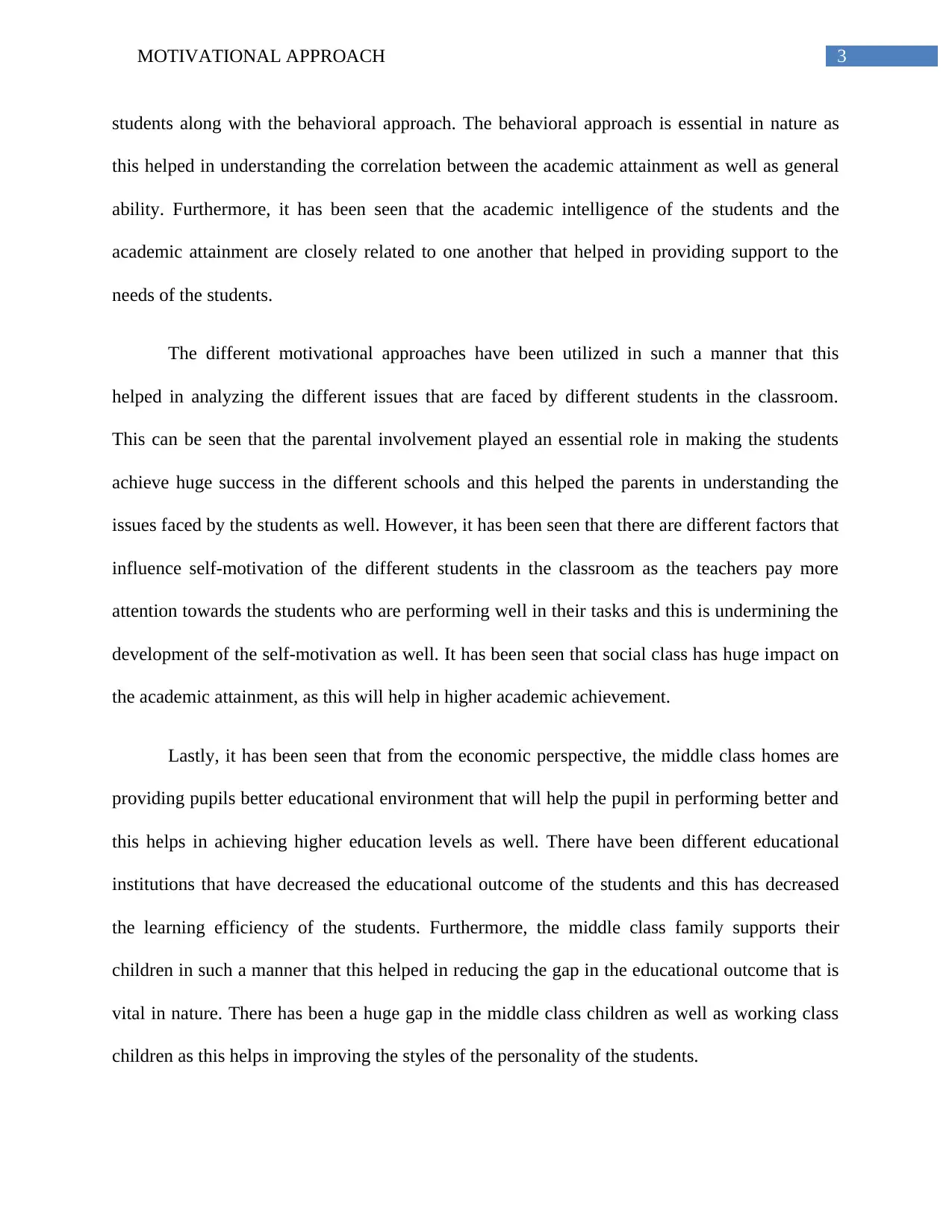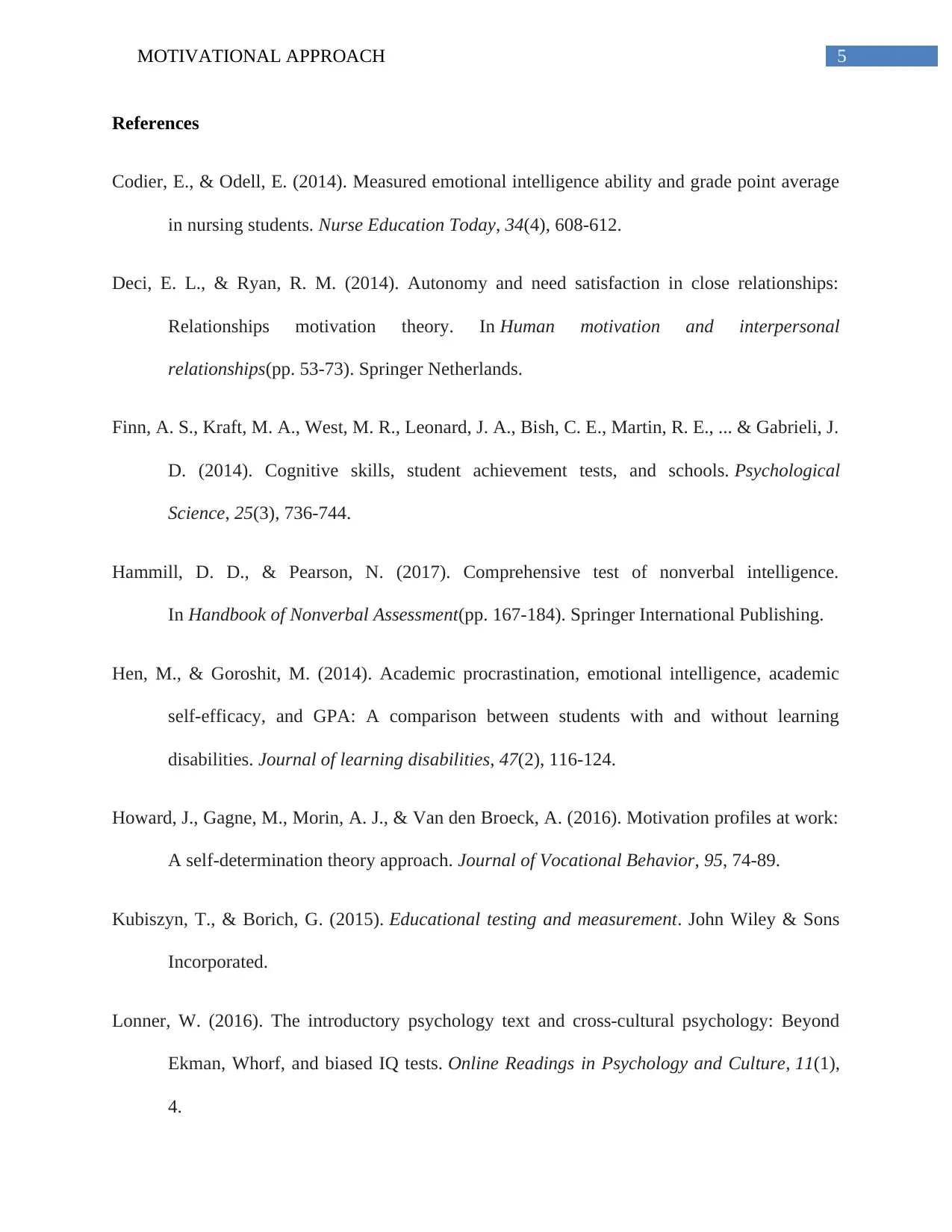Motivational Approach: Analyzing Student Academic Performance Report
VerifiedAdded on 2020/05/28
|6
|1452
|81
Report
AI Summary
This report provides an analysis of motivational approaches and their impact on student academic attainment. It begins by exploring the role of IQ tests as predictors of learning outcomes and the significance of motivation in academic achievement. The report discusses various motivational theories, including cognitive theories and the influence of contextual-environmental factors, as well as the impact of social class on academic success. It emphasizes the importance of teachers' behavior in motivating students and the need to address low performers. The report identifies techniques for schools, universities, and parents to adopt, aligning with students' and parents' expectations. It examines the use of IQ tests, motivational theories, and concepts to improve student performance, while highlighting the role of parental involvement and the impact of social class on educational outcomes. The report concludes that a combination of factors, including proper IQ tests, motivational approaches, and supportive environments, contributes to student success.

Running head: MOTIVATIONAL APPROACH
Motivational Approach
Name of the Student
Name of the University
Author note
Motivational Approach
Name of the Student
Name of the University
Author note
Paraphrase This Document
Need a fresh take? Get an instant paraphrase of this document with our AI Paraphraser

1MOTIVATIONAL APPROACH
Introduction
The report helps in analysis of the different abilities that plays an essential factor in the
measurement of the differences of the pupil and the entire determination is done through the
different IQ tests. The IQ tests are one of the predictor to analyze and predict the outcomes of
learning. The academic attainment is done and achieved through the intelligence tests that are
influential factor (Hammill & Pearson 2017). Furthermore, it can be seen that motivation plays
an essential role in the academic attainment of the different individuals (Codier & Odell 2017).
The motivation has huge impact on the different perceptions of the individuals, as the
intelligence of the pupil is not inherited in nature (Finn et al. 2014). There are different
motivational theories such as cognitive theories along with contextual-environmental factors that
will shape the personality of the students.
Furthermore, it can be seen that the social class or status of the individuals have huge
impact on the academic attainment and there are individuals who are from middle class
backgrounds, they gain more academic attainment than the children who are from the higher or
working families (Kubiszyn & Borich 2015). The entire report will provide emphasis on the
different aspects wherein the pupil will gain huge academic attainment. It can be seen that the
students who hail from the middle class backgrounds get achievements in their academic fields
and the level of the education they gain is higher in nature as well (Lonner 2016). The behavior
of the professors in the different universities and schools are essential in nature, as this will help
in motivating the students in the classrooms (Deci & Ryan 2014). It has to be the entire duty of
the teachers in the school to understand and analyze the low performer students in the class as
this will help them in making them performing better (Howard et al. 2016).
Introduction
The report helps in analysis of the different abilities that plays an essential factor in the
measurement of the differences of the pupil and the entire determination is done through the
different IQ tests. The IQ tests are one of the predictor to analyze and predict the outcomes of
learning. The academic attainment is done and achieved through the intelligence tests that are
influential factor (Hammill & Pearson 2017). Furthermore, it can be seen that motivation plays
an essential role in the academic attainment of the different individuals (Codier & Odell 2017).
The motivation has huge impact on the different perceptions of the individuals, as the
intelligence of the pupil is not inherited in nature (Finn et al. 2014). There are different
motivational theories such as cognitive theories along with contextual-environmental factors that
will shape the personality of the students.
Furthermore, it can be seen that the social class or status of the individuals have huge
impact on the academic attainment and there are individuals who are from middle class
backgrounds, they gain more academic attainment than the children who are from the higher or
working families (Kubiszyn & Borich 2015). The entire report will provide emphasis on the
different aspects wherein the pupil will gain huge academic attainment. It can be seen that the
students who hail from the middle class backgrounds get achievements in their academic fields
and the level of the education they gain is higher in nature as well (Lonner 2016). The behavior
of the professors in the different universities and schools are essential in nature, as this will help
in motivating the students in the classrooms (Deci & Ryan 2014). It has to be the entire duty of
the teachers in the school to understand and analyze the low performer students in the class as
this will help them in making them performing better (Howard et al. 2016).

2MOTIVATIONAL APPROACH
This kind of motivation theories can help in rewarding the low scorer students who
perform poor in the classroom. The different ascertainments are required to be made, as this will
help the poor students in performing better and give in their best performance as well (Codier &
Odell 2014).
The main aim and purpose of the report is to identify the different techniques that are
required to be adopted by different schools, universities along with parents of the pupil. The
different motivational theories has to be adopted in such a manner that this will help in meeting
the different expectations of the students along with their parents. The purpose is to identify the
different behaviors of the students in schools in such a manner that this will help the schools and
the parents in understanding the perspectives that are required to achieve the goals (Hen &
Goroshit 2014).
The structure of the report includes the different strategies such as IQ tests, motivational
theories and concepts that can be used to motivate the students. The different motivational
approaches has to be analyzed in order to make the students perform better in the classroom and
this will help them in improving their performance records and this will improve the
performance of the entire school as well.
Conclusion
Therefore, it can be concluded that proper IQ tests is essential in nature as this helped in
identifying the talents of the students in the schools. The measurement of the differences of the
individuals are usually measured with the help of IQ tests as this has been one of the key
indicators in the measuring the performance of the students. It has been seen from the entire
study that the motivation is another essential factor that helps in measuring the intelligence of the
This kind of motivation theories can help in rewarding the low scorer students who
perform poor in the classroom. The different ascertainments are required to be made, as this will
help the poor students in performing better and give in their best performance as well (Codier &
Odell 2014).
The main aim and purpose of the report is to identify the different techniques that are
required to be adopted by different schools, universities along with parents of the pupil. The
different motivational theories has to be adopted in such a manner that this will help in meeting
the different expectations of the students along with their parents. The purpose is to identify the
different behaviors of the students in schools in such a manner that this will help the schools and
the parents in understanding the perspectives that are required to achieve the goals (Hen &
Goroshit 2014).
The structure of the report includes the different strategies such as IQ tests, motivational
theories and concepts that can be used to motivate the students. The different motivational
approaches has to be analyzed in order to make the students perform better in the classroom and
this will help them in improving their performance records and this will improve the
performance of the entire school as well.
Conclusion
Therefore, it can be concluded that proper IQ tests is essential in nature as this helped in
identifying the talents of the students in the schools. The measurement of the differences of the
individuals are usually measured with the help of IQ tests as this has been one of the key
indicators in the measuring the performance of the students. It has been seen from the entire
study that the motivation is another essential factor that helps in measuring the intelligence of the
⊘ This is a preview!⊘
Do you want full access?
Subscribe today to unlock all pages.

Trusted by 1+ million students worldwide

3MOTIVATIONAL APPROACH
students along with the behavioral approach. The behavioral approach is essential in nature as
this helped in understanding the correlation between the academic attainment as well as general
ability. Furthermore, it has been seen that the academic intelligence of the students and the
academic attainment are closely related to one another that helped in providing support to the
needs of the students.
The different motivational approaches have been utilized in such a manner that this
helped in analyzing the different issues that are faced by different students in the classroom.
This can be seen that the parental involvement played an essential role in making the students
achieve huge success in the different schools and this helped the parents in understanding the
issues faced by the students as well. However, it has been seen that there are different factors that
influence self-motivation of the different students in the classroom as the teachers pay more
attention towards the students who are performing well in their tasks and this is undermining the
development of the self-motivation as well. It has been seen that social class has huge impact on
the academic attainment, as this will help in higher academic achievement.
Lastly, it has been seen that from the economic perspective, the middle class homes are
providing pupils better educational environment that will help the pupil in performing better and
this helps in achieving higher education levels as well. There have been different educational
institutions that have decreased the educational outcome of the students and this has decreased
the learning efficiency of the students. Furthermore, the middle class family supports their
children in such a manner that this helped in reducing the gap in the educational outcome that is
vital in nature. There has been a huge gap in the middle class children as well as working class
children as this helps in improving the styles of the personality of the students.
students along with the behavioral approach. The behavioral approach is essential in nature as
this helped in understanding the correlation between the academic attainment as well as general
ability. Furthermore, it has been seen that the academic intelligence of the students and the
academic attainment are closely related to one another that helped in providing support to the
needs of the students.
The different motivational approaches have been utilized in such a manner that this
helped in analyzing the different issues that are faced by different students in the classroom.
This can be seen that the parental involvement played an essential role in making the students
achieve huge success in the different schools and this helped the parents in understanding the
issues faced by the students as well. However, it has been seen that there are different factors that
influence self-motivation of the different students in the classroom as the teachers pay more
attention towards the students who are performing well in their tasks and this is undermining the
development of the self-motivation as well. It has been seen that social class has huge impact on
the academic attainment, as this will help in higher academic achievement.
Lastly, it has been seen that from the economic perspective, the middle class homes are
providing pupils better educational environment that will help the pupil in performing better and
this helps in achieving higher education levels as well. There have been different educational
institutions that have decreased the educational outcome of the students and this has decreased
the learning efficiency of the students. Furthermore, the middle class family supports their
children in such a manner that this helped in reducing the gap in the educational outcome that is
vital in nature. There has been a huge gap in the middle class children as well as working class
children as this helps in improving the styles of the personality of the students.
Paraphrase This Document
Need a fresh take? Get an instant paraphrase of this document with our AI Paraphraser

4MOTIVATIONAL APPROACH
Finally, it can be inferred that the social class of home is one of the predictor in analyzing
the learning outcomes of the pupil. The different analysis has been conducted by different
schools in such a way that this has helped in improving the final attainment of the different
students in the different schools. The educational successes of the students are essential in nature
as this has helped the students in performing better and this has helped them in achieving
success. Therefore, the social class, contextual and environmental factors played an essential role
in the attainment of the success among the students in the different schools.
Finally, it can be inferred that the social class of home is one of the predictor in analyzing
the learning outcomes of the pupil. The different analysis has been conducted by different
schools in such a way that this has helped in improving the final attainment of the different
students in the different schools. The educational successes of the students are essential in nature
as this has helped the students in performing better and this has helped them in achieving
success. Therefore, the social class, contextual and environmental factors played an essential role
in the attainment of the success among the students in the different schools.

5MOTIVATIONAL APPROACH
References
Codier, E., & Odell, E. (2014). Measured emotional intelligence ability and grade point average
in nursing students. Nurse Education Today, 34(4), 608-612.
Deci, E. L., & Ryan, R. M. (2014). Autonomy and need satisfaction in close relationships:
Relationships motivation theory. In Human motivation and interpersonal
relationships(pp. 53-73). Springer Netherlands.
Finn, A. S., Kraft, M. A., West, M. R., Leonard, J. A., Bish, C. E., Martin, R. E., ... & Gabrieli, J.
D. (2014). Cognitive skills, student achievement tests, and schools. Psychological
Science, 25(3), 736-744.
Hammill, D. D., & Pearson, N. (2017). Comprehensive test of nonverbal intelligence.
In Handbook of Nonverbal Assessment(pp. 167-184). Springer International Publishing.
Hen, M., & Goroshit, M. (2014). Academic procrastination, emotional intelligence, academic
self-efficacy, and GPA: A comparison between students with and without learning
disabilities. Journal of learning disabilities, 47(2), 116-124.
Howard, J., Gagne, M., Morin, A. J., & Van den Broeck, A. (2016). Motivation profiles at work:
A self-determination theory approach. Journal of Vocational Behavior, 95, 74-89.
Kubiszyn, T., & Borich, G. (2015). Educational testing and measurement. John Wiley & Sons
Incorporated.
Lonner, W. (2016). The introductory psychology text and cross-cultural psychology: Beyond
Ekman, Whorf, and biased IQ tests. Online Readings in Psychology and Culture, 11(1),
4.
References
Codier, E., & Odell, E. (2014). Measured emotional intelligence ability and grade point average
in nursing students. Nurse Education Today, 34(4), 608-612.
Deci, E. L., & Ryan, R. M. (2014). Autonomy and need satisfaction in close relationships:
Relationships motivation theory. In Human motivation and interpersonal
relationships(pp. 53-73). Springer Netherlands.
Finn, A. S., Kraft, M. A., West, M. R., Leonard, J. A., Bish, C. E., Martin, R. E., ... & Gabrieli, J.
D. (2014). Cognitive skills, student achievement tests, and schools. Psychological
Science, 25(3), 736-744.
Hammill, D. D., & Pearson, N. (2017). Comprehensive test of nonverbal intelligence.
In Handbook of Nonverbal Assessment(pp. 167-184). Springer International Publishing.
Hen, M., & Goroshit, M. (2014). Academic procrastination, emotional intelligence, academic
self-efficacy, and GPA: A comparison between students with and without learning
disabilities. Journal of learning disabilities, 47(2), 116-124.
Howard, J., Gagne, M., Morin, A. J., & Van den Broeck, A. (2016). Motivation profiles at work:
A self-determination theory approach. Journal of Vocational Behavior, 95, 74-89.
Kubiszyn, T., & Borich, G. (2015). Educational testing and measurement. John Wiley & Sons
Incorporated.
Lonner, W. (2016). The introductory psychology text and cross-cultural psychology: Beyond
Ekman, Whorf, and biased IQ tests. Online Readings in Psychology and Culture, 11(1),
4.
⊘ This is a preview!⊘
Do you want full access?
Subscribe today to unlock all pages.

Trusted by 1+ million students worldwide
1 out of 6
Related Documents
Your All-in-One AI-Powered Toolkit for Academic Success.
+13062052269
info@desklib.com
Available 24*7 on WhatsApp / Email
![[object Object]](/_next/static/media/star-bottom.7253800d.svg)
Unlock your academic potential
Copyright © 2020–2025 A2Z Services. All Rights Reserved. Developed and managed by ZUCOL.





